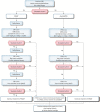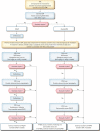2020 Korean Guidelines for Cardiopulmonary Resuscitation. Part 7. Pediatric advanced life support
- PMID: 34034451
- PMCID: PMC8171177
- DOI: 10.15441/ceem.21.027
2020 Korean Guidelines for Cardiopulmonary Resuscitation. Part 7. Pediatric advanced life support
Conflict of interest statement
No potential conflict of interest relevant to this article was reported.
Figures



Similar articles
-
2005 American Heart Association (AHA) guidelines for cardiopulmonary resuscitation (CPR) and emergency cardiovascular care (ECC) of pediatric and neonatal patients: pediatric basic life support.Pediatrics. 2006 May;117(5):e989-1004. doi: 10.1542/peds.2006-0219. Pediatrics. 2006. PMID: 16651298
-
Part 6. Pediatric advanced life support: 2015 Korean Guidelines for Cardiopulmonary Resuscitation.Clin Exp Emerg Med. 2016 Jul 5;3(Suppl):S48-S61. doi: 10.15441/ceem.16.132. eCollection 2016 Jul. Clin Exp Emerg Med. 2016. PMID: 27752646 Free PMC article. No abstract available.
-
2018 American Heart Association Focused Update on Pediatric Advanced Life Support: An Update to the American Heart Association Guidelines for Cardiopulmonary Resuscitation and Emergency Cardiovascular Care.Circulation. 2018 Dec 4;138(23):e731-e739. doi: 10.1161/CIR.0000000000000612. Circulation. 2018. PMID: 30571264
-
2019 American Heart Association Focused Update on Pediatric Advanced Life Support: An Update to the American Heart Association Guidelines for Cardiopulmonary Resuscitation and Emergency Cardiovascular Care.Pediatrics. 2020 Jan;145(1):e20191361. doi: 10.1542/peds.2019-1361. Epub 2019 Nov 14. Pediatrics. 2020. PMID: 31727859
-
2019 American Heart Association Focused Update on Pediatric Advanced Life Support: An Update to the American Heart Association Guidelines for Cardiopulmonary Resuscitation and Emergency Cardiovascular Care.Circulation. 2019 Dec 10;140(24):e904-e914. doi: 10.1161/CIR.0000000000000731. Epub 2019 Nov 14. Circulation. 2019. PMID: 31722551 Review.
Cited by
-
National Surveillance of Pediatric Out-of-Hospital Cardiac Arrest in Korea: The 10-Year Trend From 2009 to 2018.J Korean Med Sci. 2022 Nov 14;37(44):e317. doi: 10.3346/jkms.2022.37.e317. J Korean Med Sci. 2022. PMID: 36377293 Free PMC article.
-
Arterial Blood Gas Analysis for Survival Prediction in Pediatric Patients with Out-of-Hospital Cardiac Arrest.J Pers Med. 2023 Jun 28;13(7):1061. doi: 10.3390/jpm13071061. J Pers Med. 2023. PMID: 37511675 Free PMC article.
-
Comparison of paediatric basic life support guidelines endorsed by member councils of Resuscitation Council of Asia.Resusc Plus. 2023 Nov 14;16:100506. doi: 10.1016/j.resplu.2023.100506. eCollection 2023 Dec. Resusc Plus. 2023. PMID: 38033347 Free PMC article. Review.
References
-
- Maconochie IK, Aickin R, Hazinski MF, et al. Pediatric Life Support 2020 international consensus on cardiopulmonary resuscitation and emergency cardiovascular care science with treatment recommendations. Pediatrics. 2021;147(Suppl 1):e2020038505B. - PubMed
-
- Carenzi B, Corso RM, Stellino V, et al. Airway management in an infant with congenital centrofacial dysgenesia. Br J Anaesth. 2002;88:726–8. - PubMed
-
- Fraser J, Hill C, McDonald D, Jones C, Petros A. The use of the laryngeal mask airway for inter-hospital transport of infants with type 3 laryngotracheo-oesophageal clefts. Intensive Care Med. 1999;25:714–6. - PubMed
Publication types
Grants and funding
LinkOut - more resources
Full Text Sources
Other Literature Sources
Medical

